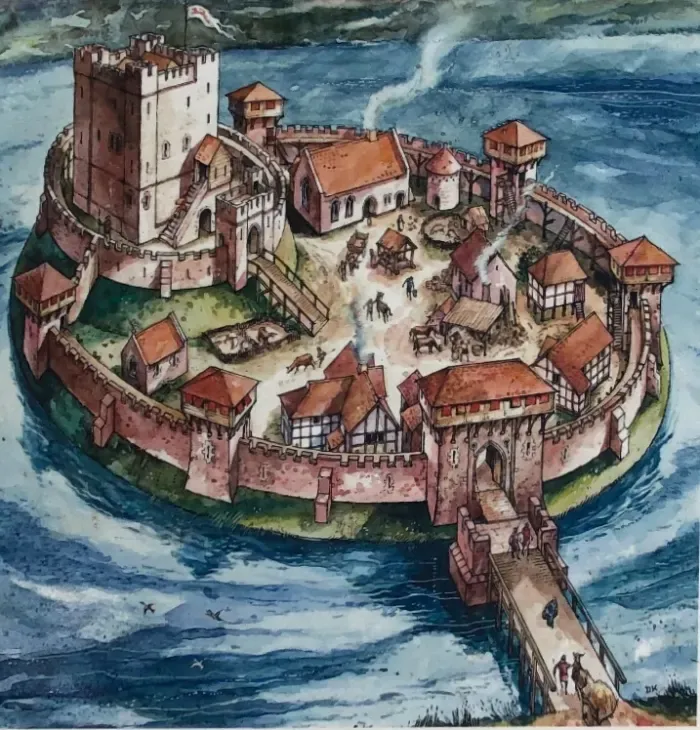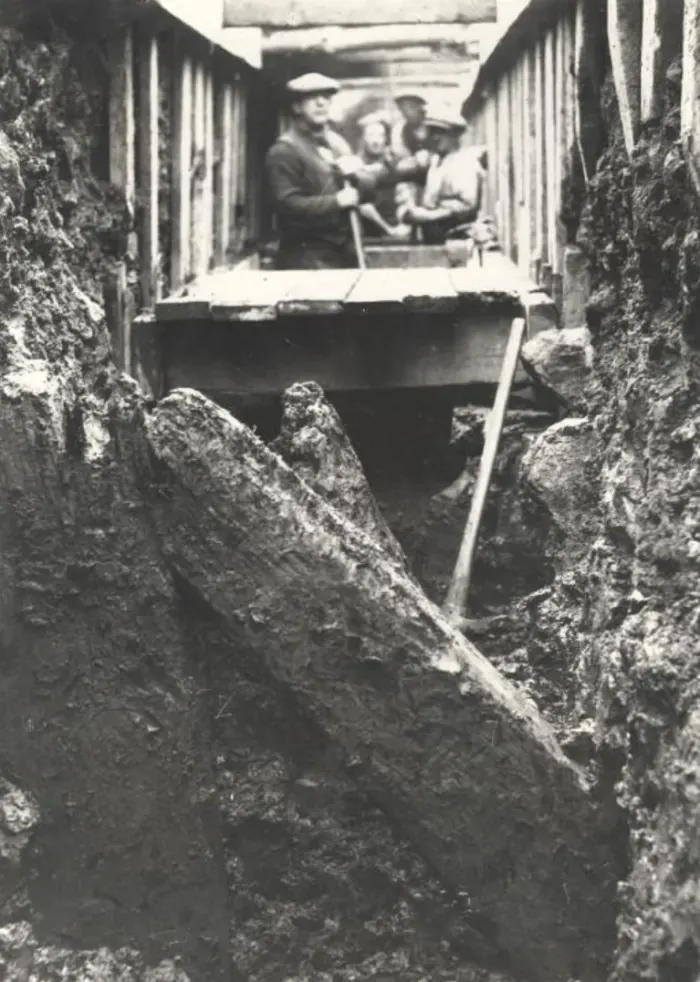Newcastle-under-Lyme was not mentioned in the Domesday Book, because there wasn't much there at that time. The town that we know and love now grew quickly around a castle that was built in the early 12th century.
This castle was built to replace an old wooden fortress at Chesterton. There are few records that survive of the castle at Chesterton, but we understand that the fortress was built on a Saxon site, but there is no record of who built it. By 1206 there were additional timber buildings and a wooden palisade added to it. At the time it was the only castle in the county N. of Stafford.
This castle soon fell into ruin after another was built just two miles away and called New Castle. The castle in Chesterton leaves no trace now, although the ruins were visible up until the end of the 16th century. The earliest record is from Samson Erdeswick's Survey of Staffordshire, whose tour of Staffordshire was taken in 1597 and he said of the castle in Chesterton;
'A little lower stands Chesterton, where are to be seen the ruins of a very ancient town or castle, there yet remaining some rubbish of lime and stone; whereby may be perceived that the walls have been of a marvellous thickness; and the name doth also argue some town, or rather castle, there is to have been seated; as also by the decay thereof, which may seem to be occasioned by the building of Newcastle, it did give cause, whereupon, as I take it, it took the name of Newcastle, though the walls thereof begin to follow the others, shewing themselves also very ruinous, and almost as little to the view, as the others do, but that they stand in a great lake or pool, as the others do not, whereby this may better be seen.'

What We Know About the Castle
The new castle was built in the 12th century on low lying ground, giving it great views of the surrounding area. The area was mostly woodland, known as the great Lyme Forest. The castle was built in the Lyme Valley.
It was built as a motte and bailey castle, within a large pool of water that was fed from the Lyme Brook and other streams. A motte and bailey castle is a type of castle that sits upon a raised area of land called a motte, topped by a building called a keep which is then surrounded by a walled courtyard called a bailey. This was all surrounded by a protective ditch or moat. These types of castles were common due to the fact that they were easy to build and easy to defend.
The New Castle also had a bridge over the moat, which was originally made of wood, but later was rebuilt out of stone. There were many buildings in the castle grounds. There was a stone tower, chapel, private apartments, kitchens, gatehouse, and a gaol. During the 13th century, the wooden buildings were replaced with stone and stables, a garrison, a chapel and a storehouse were all added and a lot of repairs and strengthening work was done to the castle's defences.
The New Castle, Silverdale Road

The Castle Falls Into Disrepair
In 1149 the castle and its lands were granted to Ranulf de Gernon, Earl of Chester, from King Stephen. It was staffed by royal staff and remained in royal control for many years. There are many records that show the extensive work done to strengthen and fortify the castle in the late 12th and early 13th century.
King Henry III granted the castle and the manor of Newcastle to his younger son Edmund, who became the Earl of Lancaster, in 1267. When Henry IV became King in 1399 the castle was no longer used as a royal stronghold. It seems that it was in a low-lying area and surrounded by higher ground which made it more vulnerable as siege warfare had advanced quickly. There are records to show that the castle was still being repaired and refurbished throughout the 15th and 16th centuries though.
However, by the latter half of the 16th century, John Leland recorded that there was little standing of the castle except for a great tower. The castle was then leased to Ralph Sneyd in 1610 and was recorded as 'altogether decayed'.
Walter Sneyd of Keele purchased the castle in 1828 and the surrounding pool from the Duchy of Lancaster. He then drained the pool to create gardens and meadows. Castle Hill Iron Foundry was built in 1855 on the side and damaged part of the motte. As time went by there was less and less of the castle visible and by the middle of the 19th century, Silverdale Road was built across the site, losing the rest of the motte. Lyme Brook was also redirected.
By this time, the remains of the castle had been buried and lost.

Rediscovery of the Castle Remains
There have been a few archaeological excavations of the castle over the years, the first being in 1895. This excavation discovered the earthwork and motte of the fort and parts of the east and west defences. Excavations in the 1930s were conducted by Thomas Pepe. A few objects were recovered, including large oak timbers and well-preserved ashlar walls. These walls are thought to have formed part of the curtain wall which was built around the bailey in the 12th century. A large stone building discovered is thought to have been a hall and a kitchen and other portions of walls discovered seem to have been part of a bridge and the remains of the gateway to the bailey. This portion of the wall, 11m long has been left partially exposed and can still be seen, as can the raised earthworks.
Development in the area has ruined most of the motte and any archaeological remains that there could have been. The area was further developed in 1955 and 1969 with housing estates being built on the site.
Unfortunately, the only remaining visible parts of the castle are the overgrown motte and the preserved castle wall.
The remaining parts of the castle and motte can be found at the end of John O'Gaunt's Road and in the park on SIlverdale Road.
OS Map Ref - SJ844545595
Latitude 53.01063 Longitude 2.23364
If you like what you have read, please feel free to support me by following and signing up for my newsletter and/or buying me a coffee!
Thank you.

If you are interested in the history of Newcastle-under-Lyme, then check out these books on Amazon.






